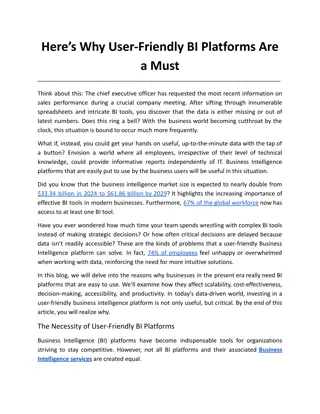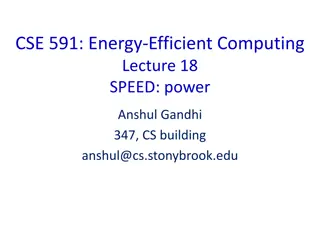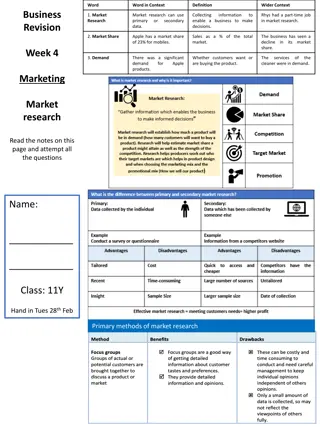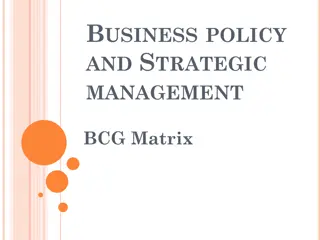Understanding Market Power in Online Platforms
This informative resource discusses the significance of market power, mechanics of market power compared to competitive markets, substantial market power (SMP), SMP in competition practices, and the impact of online platforms on market dynamics. It also explores the factors involved in establishing substantial market power and the constraints that can limit a firm's power over pricing in competitive markets.
Download Presentation

Please find below an Image/Link to download the presentation.
The content on the website is provided AS IS for your information and personal use only. It may not be sold, licensed, or shared on other websites without obtaining consent from the author. Download presentation by click this link. If you encounter any issues during the download, it is possible that the publisher has removed the file from their server.
E N D
Presentation Transcript
Online Platforms and Market Power Nicolas Petit, Isaure d Estaintot, and Natalia Moreno Belloso 20 May 2021
Outline 1. Defining Market Power, and why it Matters, 15 2. Establishing Substantial Market Power, 30 3. Complicating Factors in Online Platforms, 30 4. Q&A, 15 2
1. Defining Market Power Competitive markets Market power Allocative efficiency = price Productive efficiency = costs Dynamic efficiency = products Power over price Inertial behavior Deadweight loss 3
1.1. Mechanics of Market Power Compared to competitive markets, monopolist is price setter Decision making problem MR = MC Only works if monopolist controls industry output See the triangle? 4
1.2. Substantial Market Power (SMP) Business dynamism requires firms to earn a normal rate of return Above cost prices that persist under free and open entry denote efficiency Market power is only problematic when substantial (and durable) General Court, Case T-399/16, CK Telecoms v Commission Guidance paper on Article 102 TFEU, 9-12 5
1.3. SMP in Competition Practice Market power unlawfully acquired => merger Market power unlawfully exercised => exploitative abuse of dominance Market power unlawfully protected or strengthened => exclusionary abuse of dominance Collective market power => anticompetitive agreements 6
1.4. Online Platforms? (more => 3) Structural properties indicative of dominance But confounding factors Output growth Entry Large R&D expenditure 7
2. Establishing SMP A firm s power over price can be constrained by 2.1. 2.2. 2.3. Existence of rivals Market structure Ability of rivals to raise output Entry/expansion barriers Countervailing behavior of customers Buyer power Occasionally, Substantial market power is measured directly 2.4 Costs, prices and profits 8
2.1. Market Structure Proxies of SMP - Market share levels in absolute and relative terms (compared to competitors); - Their evolution over time 9
Market Share Levels - Close to monopoloy market share (> 75%) : sufficient indication of SMP DG Competition discussion paper 2005 - 92. - Very high market shares (50%-70%): establish SMP. Must be complemented (duration comparison with competitors). AKZO 1991; 60-61 See ECJ, - Lower market shares (25%-40%): SMP less likely: multi-dimensional assessment required. - No more than 25% : not likely to find a dominant position. DG Competition discussion paper 2005 - 31. 10
Distribution of Market Shares The higher the gap in market shares levels among competitors, the higher the SMP. the relationship between the market shares of the undertaking concerned and of its competitors, especially those of the next largest, [is a] relevant [factor] because it enables the competitive strength [ ] to be assessed . ECJ, Hoffmann-La Roche - 1979 - 48. A 50% market share is an indication of dominance provided that rivals holds a much smaller share of the market DG Competition discussion paper 2005 - 31. Also => Herfindahl-Hirschman Index (HHI) 11
Historical Evolution of Market Shares What matters is actual degree of competition in the market . A high market share is an indication of dominance provided that this market share has been held for some time flucutat[ion] is an indication of effective competition . Historic market shares [ ] may also provide useful information [ ] by indicating whether firms have been gaining or losing market shares Interpretations of market shares evolutions are context-dependent: dynamic markets, unstable structure by nature DG Competition discussion paper 2005 - 29-30. 12
Crude Proxies? Market share levels Rivals positions Timeline Others: market shares only a proxy. Additional tests must be applied 13
2.2. Relevant Q: Can Rivals raise Output? Not if entry or expansion barriers Entry/expansion barriers Again, highly contextual evaluation: - industry history (past successes and failures) - likely reaction of incumbent If entry/expansion is likely, sufficiently immediate and persistent, and of sufficient scope and magnitude, then high market shares do not necessarily translate into market power. 14
2.2. Entry/expansion barriers Examples Legal barriers to entry: - IP rights : not per se barriers: Although the mere possession of intellectual property rights cannot be considered to confer such a position, their possession is none the less capable, in certain circumstances, of creating a dominant position, in particular by enabling an undertaking to prevent effective competition on the market General Court, AstraZeneca 2010 - 270. - Legal monopoly, exclusive rights, etc. - Tariffs 15
2.2. Entry/expansion barriers Structural barriers - Firms capabilities: vertical integration, economies of scale and scope, highly developed distribution and sales network (ECJ, Michelin 1983 - 58), production capacities (Id, 51) - Absolute cost advantages: high level of necessary preliminary investments, privileged access to supply, - Incumbency advantages: first-mover advantage, network effects, reputation (Commission, Intel 2009 - 867-s); Coca-Cola - 2005, high-switching costs for consumers and inertia (Commission, Microsoft 2009 - 47-48 ) 16
2.3. Buyer power? A buyer may be sufficiently powerful to constrain price setter. Very little case-law on this. But vertical integration, sponsoring of alternative suppliers, or availability of alternatives allow a buyer to defeat exercise of power over price and output Commission, Virgin/British Airways - 1999 : BA's position on the markets for air transport make it an obligatory business partner for travel agents. [ ] Regardless of the conditions on which BA buys these services from travel agents, agents have to deal with BA and accept that a large portion of their income from these services will be that generated by the sale of BA tickets. General Court, Societ Italiana Vetro SpA 1992 : The Commission has not even attempted to gather the information necessary to weigh up the economic power of the three producers against that of Fiat, which could cancel each other out. 17
2.4. Costs, prices and profits Lerner Index Pricing analysis Profitability analysis Residual demand elasticity But far from information light , and methodological issues 18
3. Complicating Factors in Online Platforms Directly assessing SMP by looking at e.g. mark-ups, profitability or price elasticities is fraught with conceptual difficulties for online platforms. Indirectly assessing SMP: 3.2. Entry barriers 3.3. Buyer power 3.1. Market shares Several entry barriers are particularly relevant in online platforms Characteristics of online platforms make the exercise of buyer power unlikely Characteristics of online platforms complicate the use of market shares 3.4. single/multi-homing 3.5. dynamic competition Additional considerations: 19
3.1. Market shares Two main complicating factors (1) Multi-sidedness (2) Use of zero prices Key question: at which level to measure market shares? Key question: shares of what? - SMP as power over price: metrics relying on monetary units are inapplicable - SMP as power over output: metrics relying on output units face selection problems b/c many different data points could represent production output Several possibilities: - Look at the shares on only one side - Look at all sides simultaneously - Look at all sides separately Example: Commission, Google Android 2018. Example: Bundeskartellamt, Facebook 2019. 20
3.2. Entry/expansion barriers Entry barriers could result from the nature of the digital product/service or the conduct of the platform. Entry barriers typically identified in digital market: Network effects users have no incentive to switch if they expect most users will not switch tipping Possession of or access to data examples: Bundeskartellamt, Facebook (2019); Commission, Google Shopping (2017) and Google Android (2018) Economies of scale digital markets often exhibit significant economies of scale Presence in multiple markets access to different data sources leveraging potential example: Commission, Google AdSense (2019). User switching costs can go hand in hand w/ network effects example: Commission, Google Android (2018) 21
3.3. Buyer power In principle, buyer power could play a role in the market power analysis for digital platforms. However, the exercise of countervailing power is unlikely due to: - Fragmentation of users - Strong network effects. 22
3.4. Single- or multi-homing? (1) Relevance for the use of market shares The easier it is to migrate between services, the higher the competitive constraint. High market shares w/ multi-homing might not indicate market power. Multi-homing can lead to double counting: e.g. shares of the total number of users do not capture user engagement. Example: Commission, Google Android (2018) (2) Relevance for the assessment of entry barriers Single-homing can result from or reinforce barriers to entry and expansion (e.g. network effects, switching costs and brand loyalty). Absence of multi-homing could indicate market power. Examples: Bundeskartellamt, Facebook (2019); Commission, Google Android (2018) 23
3.5. Dynamic competition Competition is often for the market with drastic innovations rather than static price/output competition - Especially prevalent: indirect (rather than direct) entry by innovative entrants (1) Relevance for the use of market shares High market shares could be only temporary, due to the existence of actual or potential innovative threats Necessary to consider the evolution of market shares: when maintained for a significant period of time, high shares could reflect substantial market power. Example: Commission, Google Shopping (2017) (2) Relevance for the assessment of entry barriers Key question: are there barriers to dynamic competition? Example: Commission, Microsoft/Skype (2011) 24
Conclusions Law Economics Proposed Digital Markets Act (DMA) sweeps market power issues under the rug: https://papers.ssrn.com/sol3/papers.cf m?abstract_id=3843497 Role for private enforcement Courts key role in helping clarify the law Weird properties of the demand curve, and economies of scale Disequilibrium properties not well accounted for 25
Cases Judgment of the Court of 13 February 1979, Hoffmann-La Roche & Co. AG v Commission of the European Communities; Case 85/76. Judgment of the Court (Fifth Chamber) of 3 July 1991, AKZO Chemie BV v Commission of the European Communities; Case C-62/86. Judgment of the General Court (Sixth Chamber, extended composition) of 1 July 2010, AstraZeneca AB and AstraZeneca plc v European Commission; T 321-05. Commission Decision of 13 May 2009; Case COMP/C-3/37.990 Intel. Commission decision of 22 June 2005; Case COMP/A.39.116/B2 Coca-Cola. Commission Decision of 14 July 1999; 2000/74/EC -Virgin/British Airways. Judgment of the Court of First Instance (First Chamber) of 10 March 1992, Societ Italiana Vetro SpA, Fabbrica Pisana SpA and PPG Vernante Pennitalia SpA v Commission of the European Communities; Joined cases T-68/89, T-77/89 and T-78/89. Judgment of the Court of 9 November 1983, NV Nederlandsche Banden Industrie Michelin v Commission of the European Communities; Case 322/81. Commission Decision of 30 January 2008; Case COMP/M.4734 -Ineos/ Kerling. Commission Decision of 27 June 2017; Case COMP/AT.39740 Google Search (Shopping) Commission Decision of 18 July 2018; Case COMP/AT.40099 Google Android Commission Decision of 20 March 2019; Case COMP/AT.40411 Google Search (AdSense) Bundeskartellamt Decision of 6 February 2019, Facebook; B6-22/16. 26























